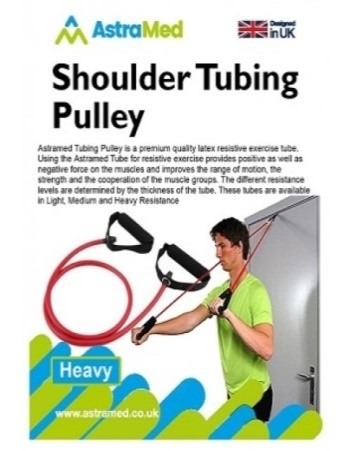Shoulder Pulley Physical Therapy, Increased Range of Motion, and Flexibility Exercises with Over Door Attachment, Smooth Pulley and Comfort Handles
₨1500
In stock
About this item
Increases flexibility and range of motion in shoulder movement
Safely rehab shoulder and rotator cuff injuries
Stretch and improve circulation in upper body muscles
Foam cushion assistive grip for comfort and safety
Patented grip-all ball for safe, fast rope length adjustment
How a Shoulder Pulley Works on a Kinesiological Level
Recovery from a shoulder injury can be a long process requiring multiple stages of rehabilitation. There may be surgery. There will likely be an extended period of immobilization as healing progresses, followed by a carefully planned exercise program. Full recovery can take months, during which time patients will become intimately familiar with an array of physical therapy tools—including one known as the shoulder pulley.
Shoulder pulleys have been used for many years to treat shoulder injuries. Originally they were cumbersome devices fixed to the walls of physical therapy clinics. PrePak Products’ Bill Bollinger developed the first portable shoulder pulley for home use, and decades later his Home Ranger remains the leading shoulder pulley on the market.
But What Problem Does the Shoulder Pulley Address?
After injury or surgery, keeping the shoulder at rest is critical. The body must be allowed to perform its natural healing processes. If you’re dealing with a broken bone or torn muscle, any jolting or jarring of partially healed tissue could erase the progress of recovery. And so patients are instructed to keep their arms in a sling and to keep their shoulder immobile. This phase could last for weeks.
The trouble, though, is that keeping a joint immobile causes problems of its own. A joint that doesn’t get used can freeze up. Scar tissue can form. The range of motion can become severely limited. And so during office visits, a physical therapist will perform passive range of motion exercises with the patient. While the patient keeps the muscles of their arm and shoulder relaxed, the PT manipulates the arm to move the joint through various ranges of motion. As long as the patient does not engage the muscles, this gives the joint the movement it needs without stressing the injury.
These passive range of motion exercises help the patient avoid setbacks and side effects along the road to recovery.
Is Passive Range of Motion Possible Without a Physical Therapist?
While it’s extremely important that your shoulder rehabilitation is supervised by a doctor or physical therapist, it’s not always practical to visit your PT every day just for a few minutes of range of motion exercises. That’s where the shoulder pulley comes in.
A shoulder pulley is a simple rope-and-pulley device that attaches to any standard door. While holding a handle of the rope in each hand, you pull with your good arm to move your healing shoulder through its passive range of motion exercises.
There are a variety of exercises that can be performed with the shoulder pulley. There’s abduction, rotation, elevation, and flexion, facing toward the pulley or away. The exercises you need depend on your particular circumstances and the instructions of your doctor or PT.
The shoulder pulley is just one of many physical therapy tools available to patients. But it has proven itself time and time again as a valuable part of the recovery process for people with shoulder
Vendor Information
- Store Name: Aair Medicals
- Vendor: Aair Medicals
- No ratings found yet!
-
-
₨45000
-
-
Thera Putty 85 g Blue Firm
Sold By: Aair Medicals₨1150














Reviews
There are no reviews yet.